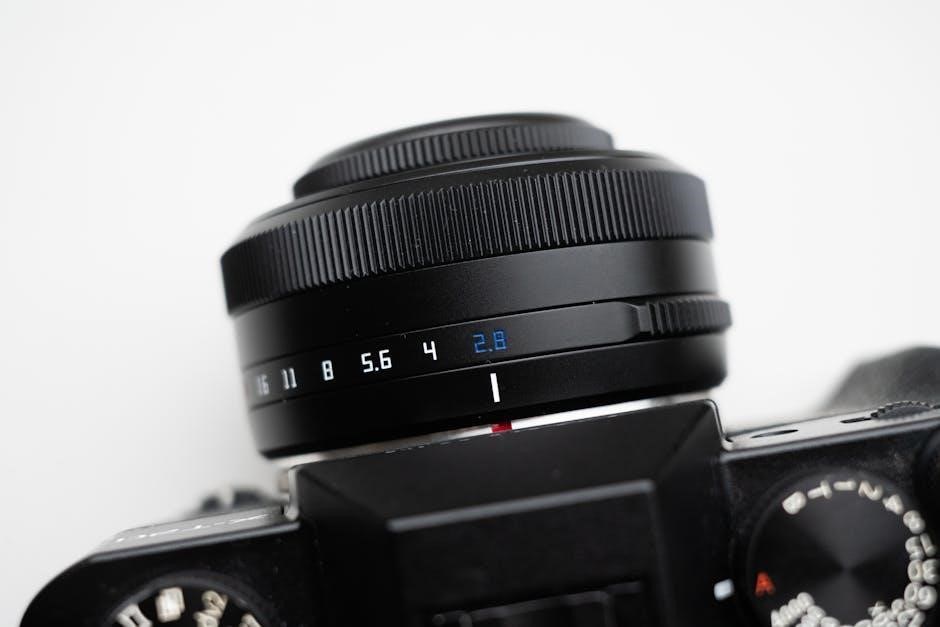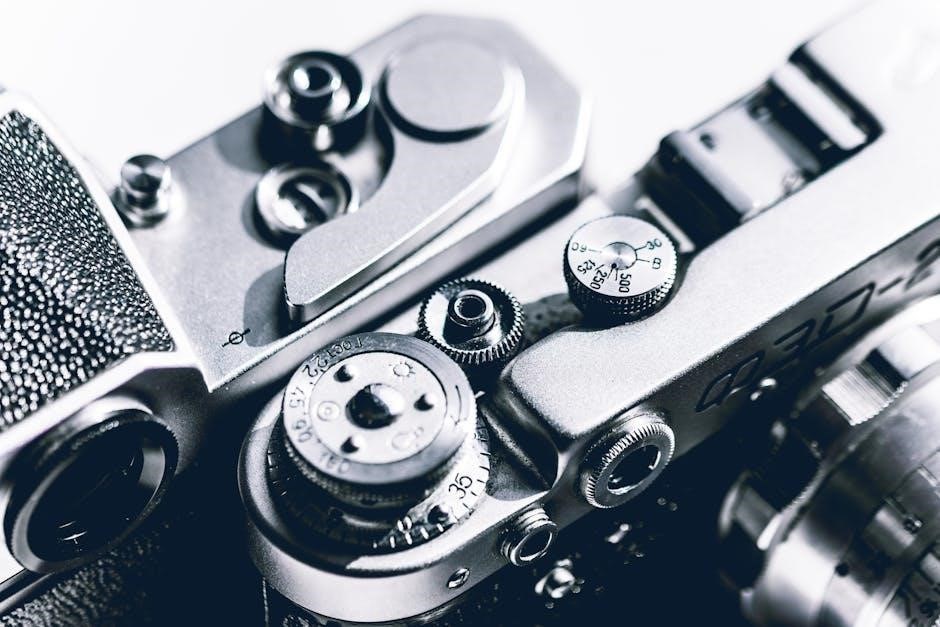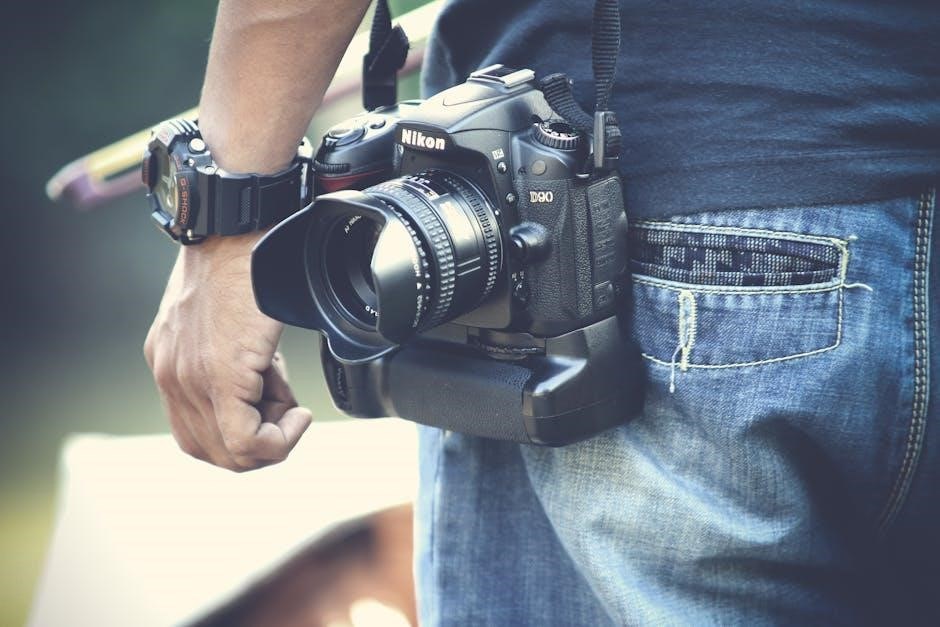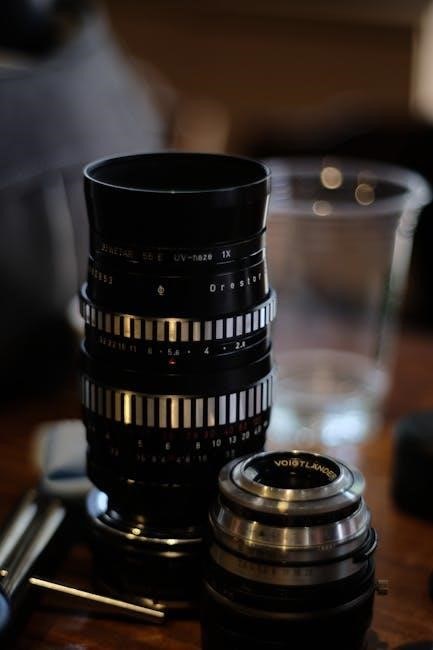
Welcome to the Zoom H1 Owner’s Manual! This guide helps you master the Zoom H1 Handy Recorder, covering its features, setup, and troubleshooting for optimal use.
1.1 Overview of the Zoom H1 Handy Recorder
The Zoom H1 Handy Recorder is a compact, portable device designed for high-quality audio recording. It features a built-in XY stereo microphone, capturing crisp, immersive sound. Lightweight and easy to use, it supports various formats like WAV and MP3. The H1 is ideal for podcasters, videographers, and musicians, offering essential controls for gain adjustment and a user-friendly interface. Its robust design ensures reliability in diverse environments. Whether for professional or casual use, the Zoom H1 delivers excellent audio performance, making it a versatile tool for capturing life’s moments with clarity and precision.
1.2 Importance of Reading the Owner’s Manual
Reading the Zoom H1 Owner’s Manual is essential to unlock its full potential. It provides detailed insights into the recorder’s features, settings, and troubleshooting tips. By understanding the manual, users can optimize audio quality, navigate the menu system efficiently, and avoid common issues. The manual also explains how to maintain the device, update firmware, and resolve technical problems. Whether you’re a novice or an experienced user, the manual serves as a comprehensive guide to ensure you get the best recording experience. It helps you make informed decisions about settings and accessories, enhancing your overall productivity and creativity with the Zoom H1.
1.3 Key Features of the Zoom H1
The Zoom H1 Handy Recorder is equipped with a built-in 90-degree XY microphone, capturing high-quality stereo audio. It supports MP3 and WAV formats, with adjustable bitrates for flexibility. The device is lightweight and portable, making it ideal for field recordings. It features a microSD card slot, allowing for expandable storage up to 32GB. The H1 also includes a 3.5mm input for external microphones and a headphone/line output for monitoring. It operates on two AAA batteries, offering up to 10 hours of recording time. The H1 is compatible with both Mac and PC, enabling seamless file transfer via USB. Its intuitive design and robust features make it a versatile tool for podcasting, interviews, and live recordings.
1.4 Target Audience for the Manual
This manual is designed for individuals seeking to maximize the potential of the Zoom H1 Handy Recorder. It caters to podcasters, musicians, videographers, and journalists who need clear guidance on recording techniques and device functionality. Beginners will find detailed setup instructions, while advanced users can explore specialized features like audio interfaces and external microphone integration. The manual is also beneficial for educators and students interested in audio production. By addressing a broad range of users, it ensures that everyone can effectively utilize the H1’s capabilities for professional and personal projects, making it an essential resource for anyone involved in audio recording.

Design and Build of the Zoom H1
The Zoom H1 features a lightweight, portable design with a durable build, making it ideal for on-the-go recording. Its compact body houses a high-quality XY microphone for clear audio capture.
2.1 Physical Layout and Controls
The Zoom H1 is designed with user-friendly controls, featuring a simple and intuitive layout. The recorder has a power button, volume wheel, and transport controls for easy operation. The 1.25-inch LCD screen displays essential information like recording time and battery life. The microphone is positioned on top for optimal sound capture, while the SD card slot and USB port are conveniently located on the side. The lightweight design ensures portability, making it easy to carry in a pocket or bag. The H1’s controls are responsive and allow quick access to settings, enabling seamless adjustments during recording sessions. Its ergonomic design enhances usability for professionals and beginners alike.

2.2 Built-in XY Microphone
The Zoom H1 features a high-quality built-in XY microphone, designed to capture clear and detailed stereo audio. The XY configuration ensures a wide stereo image, making it ideal for recording meetings, interviews, and live performances. The microphone is angled at 90 degrees, allowing it to pick up sound from both sides evenly. It supports a wide frequency response, delivering natural and accurate sound reproduction. The built-in mic is also capable of handling high sound pressure levels, reducing distortion in loud environments. This makes it versatile for various recording scenarios, from quiet voice memos to dynamic live sessions. The H1’s XY microphone is a key feature that sets it apart as a portable and professional recording solution.
2.3 Lightweight and Portable Design
The Zoom H1 is crafted with a lightweight and portable design, making it easy to carry wherever you go. Weighing only about 2.5 ounces, it fits comfortably in your hand or pocket. Its compact dimensions ensure it won’t add bulk to your bag, perfect for field recordings. The recorder is built with durability in mind, featuring a robust plastic body that withstands regular use. The lightweight design enhances mobility, allowing you to capture high-quality audio in any environment without being weighed down. This portability makes the H1 an excellent choice for journalists, podcasters, and musicians who need a reliable, on-the-go recording solution. Its ergonomic shape and intuitive controls further enhance its portability and usability.
2.4 Durable Construction and Materials
The Zoom H1 boasts a durable construction designed to withstand regular use and varying environments. Its lightweight yet robust plastic body ensures longevity, while the built-in XY microphone is protected to maintain optimal audio performance. The recorder’s compact design includes a secure SD card slot and a reliable battery compartment, both crafted for long-term durability. The H1’s materials are selected to resist wear and tear, ensuring it remains functional even with frequent handling. Its sturdy build makes it suitable for field recordings, travel, and professional applications. Despite its portability, the H1 is built to last, offering users a dependable tool for capturing high-quality audio in any setting.

Getting Started with the Zoom H1
Unbox your Zoom H1, insert the SD card, and charge the battery. Familiarize yourself with the intuitive menu system to begin recording high-quality audio effortlessly.
3.1 Unboxing and Initial Setup
Begin by carefully unboxing your Zoom H1 Handy Recorder. Ensure all components, including the recorder, USB cable, and user manual, are included. Before first use, charge the battery using the provided USB cable. Next, insert a compatible SD card into the slot located on the side of the device. Power on the H1 by sliding the power switch upwards. The device will boot up, and you’ll be prompted to set the date and time. This initial setup ensures proper organization and timestamping of your recordings. Familiarize yourself with the controls and menu navigation to prepare for your first recording session.
3.2 Inserting the SD Card
To insert an SD card into your Zoom H1, first ensure the device is powered off. Locate the SD card slot on the side of the recorder. Carefully insert the card into the slot until it clicks into place. Use a compatible SD or SDHC card with a capacity of 2GB to 32GB. For optimal performance, format the SD card directly in the H1 using the menu system. This ensures compatibility and proper file organization. Once inserted, turn the device on and confirm the card is recognized. Proper SD card installation is essential for recording and storing your audio files effectively. Always use a high-quality card to prevent recording interruptions or data loss.
3.3 Charging the Battery
To charge the Zoom H1, connect it to a computer using the provided USB cable. The recorder will power on automatically. Charging typically takes about 2 hours for a full charge. The power button’s LED will turn red during charging and green when fully charged. For faster charging, use an external USB charger (not included). Ensure the device is turned off during charging for optimal efficiency. Never use a damaged USB cable or charger, as this could harm the device. Always charge the battery before extended use to ensure uninterrupted recording sessions. Proper charging habits will help maintain the longevity of your Zoom H1’s battery life.
3.4 Basic Navigation of the Menu System
Navigating the Zoom H1’s menu system is intuitive and straightforward. Press the MENU button to access the main menu, which includes options like REC, PLAY, FILE, and SETUP. Use the SCROLL wheel to navigate up and down through the menu items. Press the SCROLL wheel inward to select an option. Use the PLAY/PAUSE and REW/FAST-FORWARD buttons to adjust settings within each menu. The HOME menu provides quick access to frequently used settings. To exit the menu, press the MENU button again. Familiarize yourself with these controls to efficiently customize settings for your recording needs. The manual provides a detailed overview of each menu option for further customization.

Recording Features and Settings
The Zoom H1 offers versatile recording options, including MP3 and WAV formats, low-cut filter, and automatic gain control. Adjust settings like microphone gain, recording format, and sample rate to optimize audio quality for your needs. Use the built-in XY microphones or connect external mics for enhanced sound capture. Enable the low-cut filter to reduce low-frequency noise and use AGC for consistent levels. These features ensure high-quality recordings in various environments, from podcasts to live performances.
4.1 Understanding Audio Quality Settings
Understanding audio quality settings on the Zoom H1 is crucial for achieving professional-grade recordings. The device supports both MP3 and WAV formats, with WAV offering higher fidelity at the cost of larger file sizes. For optimal results, select the 32-bit float WAV option to maintain pristine audio quality throughout the recording and editing process. The low-cut filter is essential for minimizing low-frequency noise, such as ambient rumble, while automatic gain control (AGC) helps stabilize audio levels. Adjust these settings based on your recording environment to ensure clear and balanced sound. Experimenting with different configurations will help you tailor the H1 to your specific needs, whether for podcasts, interviews, or live performances.
4.2 Using the Built-in Microphone
The Zoom H1 Handy Recorder features a built-in 90-degree XY microphone, designed for capturing high-quality stereo audio. This configuration is ideal for recording a wide soundstage, making it perfect for live performances, interviews, and field recordings. To achieve the best results, position the microphone at chest level and approximately 6-8 inches from your sound source. Adjust the microphone’s angle to suit your recording environment, ensuring it faces the sound source directly. For outdoor use, consider using the windscreen accessory to minimize wind noise. Proper placement and orientation are key to leveraging the full potential of the H1’s built-in microphone for clear and immersive recordings.
4.3 Connecting External Microphones
The Zoom H1 allows you to connect external microphones for enhanced flexibility in recording. Use the 3.5mm input jack to plug in your external microphone. Ensure the MIC/LINE switch is set to “MIC” for microphone-level devices or “LINE” for line-level sources. This ensures proper audio signal routing. For monitoring, the PHONE/LINE OUT jack enables real-time audio preview through headphones; When using an external microphone, position it close to the sound source for optimal clarity. This feature is ideal for capturing vocals, instruments, or ambient sounds with precision. Always use high-quality cables to minimize interference and maintain audio integrity.
4.4 Adjusting Gain Levels
Adjusting gain levels on the Zoom H1 is crucial for achieving high-quality recordings. Use the gain control to set optimal levels, ensuring your audio is neither too quiet nor distorted. Access the gain settings through the menu system by scrolling to the “REC” menu and selecting “GAIN.” The H1 features a backlit gain wheel, allowing easy adjustments even in low-light conditions. The LED indicators provide visual feedback: green for optimal levels, red for distortion, and yellow for intermediate levels. For external microphones, set the MIC/LINE switch appropriately and adjust gain carefully to avoid clipping. Proper gain staging ensures clear, professional-sounding recordings, whether you’re capturing vocals, instruments, or ambient audio. The H1 also supports 32-bit float WAV files, which maintain audio quality even during level adjustments.

Playback and File Management
Efficiently manage and play back recordings with the Zoom H1. Navigate through files, organize folders, and transfer audio to your computer for editing or storage.
5.1 Playing Back Recordings
Playing back recordings on the Zoom H1 is straightforward. Use the play/pause button to start or stop playback. Adjust the volume using the volume wheel for optimal listening. You can also use the fast-forward and rewind functions by pressing and holding the play/pause button. The H1 supports various audio formats, including WAV and MP3, ensuring compatibility with your files. For easier navigation, use the menu to select specific files or folders. The built-in speaker provides clear audio playback, making it convenient to review your recordings on the go. This feature is essential for verifying audio quality and making necessary adjustments before further use.
5.2 Organizing Files and Folders
Organizing files and folders on the Zoom H1 ensures efficient access to your recordings. Use the menu to create and manage folders, allowing you to categorize recordings by date, project, or type. Rename files and folders directly on the device for clarity. The H1 supports hierarchical folder structures, making it easy to locate specific files. Regularly organizing your files helps prevent clutter and ensures smooth operation. Use logical naming conventions, such as including dates or keywords, to simplify file management. This feature is particularly useful for professionals who handle multiple projects or large volumes of recordings; Proper organization enhances productivity and reduces the risk of losing important files.
5.3 Transferring Files to a Computer
Transferring files from the Zoom H1 to your computer is a straightforward process. Use a USB cable to connect the device to your PC or Mac. The H1 will automatically appear as a removable drive in your file explorer or finder. Navigate to the SD Card folder, where your recordings are stored. Drag and drop the desired files to your computer’s storage. You can also use external card readers for faster transfers. Once copied, files can be edited using DAWs or other audio software. Ensure your computer recognizes the device before starting the transfer to avoid any issues. This method allows seamless integration of your recordings into your workflow, maintaining high audio quality throughout the process.
5.4 Formatting the SD Card
Formatting the SD card ensures optimal performance and compatibility with the Zoom H1. To format, go to the Menu, select System, and choose Format. This process erases all data, so back up important files first. The H1 supports SD, SDHC, and SDXC cards up to 32GB. Formatting prepares the card for recording, ensuring proper file allocation and preventing potential issues. Use the H1’s built-in formatting feature rather than formatting on a computer for best results. Always format a new card before first use to ensure compatibility and reliability. This step is crucial for maintaining audio quality and avoiding recording errors. Regular formatting helps keep your H1 functioning smoothly.

Connectivity and Compatibility
The Zoom H1 connects seamlessly to computers via USB, serving as an audio interface. It is compatible with both Windows and macOS, ensuring easy integration with recording software.
6.1 Connecting the Zoom H1 to a Computer
To connect the Zoom H1 to your computer, use a USB cable. Plug the USB-C end into the H1 and the other end into your computer’s USB port. The device will automatically be recognized, allowing you to transfer files or use it as an audio interface. Ensure your computer has the necessary drivers installed for optimal compatibility. This connection also enables charging the H1’s battery while it’s plugged in. For a stable connection, use a high-quality USB cable and avoid hubs to maintain data transfer integrity.
6.2 Using the Zoom H1 as an Audio Interface
The Zoom H1 can function as a USB audio interface, enabling direct recording to your computer. Connect it via USB, and select the H1 as your audio input device in your recording software. This setup is ideal for podcasting or voice-overs, offering high-quality audio capture. The H1’s preamps ensure low noise and clear sound. Once connected, you can monitor recordings in real-time and adjust levels using the H1’s controls. This feature makes the H1 a versatile tool for both field and studio recording, providing professional-grade audio quality with ease of use.
6.3 Compatibility with Different Operating Systems
The Zoom H1 is compatible with both Windows and macOS operating systems, ensuring seamless integration with your computer. Connect the recorder via USB, and it will be recognized as an audio input device. No additional drivers are required for basic functionality. For advanced use, install the Zoom Audio Interface driver from the official website. The H1 works with popular DAWs like Audacity, GarageBand, and Logic Pro. Compatibility extends across various OS versions, including Windows 10/11 and macOS 10.15 or later. This versatility makes the H1 a reliable choice for musicians, podcasters, and content creators. Always ensure your firmware is updated for optimal performance across different operating systems.
6.4 Integrating with Recording Software
The Zoom H1 seamlessly integrates with popular recording software, making it an ideal tool for podcasters and musicians. Connect the H1 to your computer via USB and select it as the input device in your DAW. Compatible with Audacity, GarageBand, and Logic Pro, the H1 delivers high-quality audio directly into your projects. For optimal performance, enable the H1 as an audio interface in the menu and adjust buffer settings in your software. The recorder also supports 32-bit float WAV files, ensuring superior audio quality during recording and editing. This integration makes the H1 a versatile and essential tool for capturing professional-grade audio in various creative workflows.

Advanced Features and Techniques
Explore advanced features like the low-cut filter, AGC, and customizable settings to enhance your recording experience. Learn techniques for live recording and professional audio capture.
7.1 Using the Low-Cut Filter
The low-cut filter on the Zoom H1 reduces low-frequency noise, such as wind or handling sounds. To enable it, navigate to the menu, select Low Cut Filter, and choose from Off, 80Hz, or 120Hz. For outdoor recordings or when using the built-in microphone, enabling the low-cut filter minimizes unwanted rumble. Experiment with different settings to find the optimal balance for your recording environment. This feature is particularly useful in noisy or windy conditions, helping to ensure clearer and more professional audio quality.
7;2 Enable and Disable AGC (Automatic Gain Control)
The Zoom H1’s Automatic Gain Control (AGC) automatically adjusts recording levels to optimize audio quality. To enable or disable AGC, go to the menu, select AGC, and choose from Low, Medium, High, or Off. AGC is useful for balancing levels in unpredictable environments but may not be ideal for professional recordings requiring precise control. Disable AGC for manual gain adjustment, ensuring more consistent audio in controlled settings. Experiment with AGC settings to find the best fit for your recording needs, whether in quiet studios or noisy outdoor environments.
7.3 Customizing Settings for Different Recording Scenarios
Customizing settings on the Zoom H1 ensures optimal performance in various recording environments; For live events, enable the Low-Cut Filter to reduce bass frequencies and minimize stage vibrations. When recording vocals or podcasts, disable AGC and manually adjust gain levels for precise control. Outdoor recordings benefit from higher MP3 bitrates to capture crisp, clear audio. Adjust the XY Microphone Angle to focus on specific sound sources. Experiment with WAV/MP3 formats to balance quality and storage needs. Organize files into folders for easy access and transfer recordings to your computer via USB for post-production. Tailor these settings to match your recording goals for professional results.
7.4 Using the Zoom H1 for Live Recording
The Zoom H1 excels in live recording scenarios, offering portability and high-quality audio capture. Position the recorder strategically to maximize sound pickup, ensuring the XY microphones face the source. For loud environments, use the built-in Low-Cut Filter to minimize bass distortion. Connect external microphones via the 3.5mm input for enhanced flexibility. Adjust gain levels carefully to avoid clipping, and enable AGC for automatic volume control if needed. Organize recordings into clear folders for easy access. Use WAV format for uncompressed audio or MP3 for smaller file sizes. After the performance, transfer files to your computer via USB for editing or sharing. The H1’s lightweight design makes it ideal for capturing live performances effortlessly.

Maintenance and Troubleshooting

Regularly clean the H1’s microphones and update firmware for optimal performance. Troubleshoot common issues like low audio quality or connectivity problems by resetting settings or consulting the manual.
8.1 Updating Firmware
Updating the Zoom H1’s firmware ensures you have the latest features and bug fixes. Connect the H1 to your computer via USB and launch the Zoom Firmware Update Tool from the official Zoom website. Follow on-screen instructions to check for updates and install the new firmware. During the update, do not disconnect the device or turn it off. Once complete, restart the H1 to apply the changes. Regular firmware updates maintain optimal performance and compatibility with your recording needs.
8.2 Cleaning and Maintaining the Microphone
Regular cleaning and maintenance of the Zoom H1’s built-in XY microphone ensure optimal sound quality. Use a soft, dry cloth to gently wipe away dust or debris. For stubborn dirt, lightly dampen the cloth with water, but avoid harsh chemicals or liquids. Never touch the microphone grille with sharp objects, as this can cause damage. For outdoor recordings, consider using a windscreen to reduce wind noise. Store the H1 in a protective case or pouch when not in use to prevent dust accumulation. Avoid exposing the microphone to extreme temperatures or humidity. By maintaining the microphone, you preserve the H1’s ability to capture crisp, clear audio.
8.3 Common Issues and Solutions
If the Zoom H1 fails to turn on, ensure the battery is charged or try using an AC adapter. For distorted audio, lower the gain levels or enable the Low-Cut Filter. If recordings are too quiet, increase the mic sensitivity. SD card errors often occur with incompatible or damaged cards; format the card in the H1 or replace it. For file transfer issues, connect the H1 to your computer via USB and select the correct mode. If the device freezes, reset it by holding the power button for 10 seconds. Regularly update firmware to resolve bugs and improve performance. Always use high-quality SD cards and keep the microphone clean for optimal functionality.
8.4 Resetting the Zoom H1 to Factory Settings
To restore the Zoom H1 to its factory settings, press and hold the Power and Menu buttons while turning the device on. This will reset all settings to their default configuration. Note that this process will erase all user data, so ensure all important recordings are backed up before proceeding. Resetting is useful for resolving persistent software issues or preparing the device for sale. After the reset, the H1 will restart, and you can set it up as if it were new. This step is recommended only when other troubleshooting methods fail, as it will remove all custom settings and preferences.
 scag freedom z owners manual
scag freedom z owners manual  nuwave oven pro plus manual
nuwave oven pro plus manual  nuna pipa urbn manual
nuna pipa urbn manual  hobart tigwave 250 ac dc manual
hobart tigwave 250 ac dc manual  maxi cosi pria instruction manual
maxi cosi pria instruction manual  valentía 2 libro pdf descargar gratis
valentía 2 libro pdf descargar gratis  instructions for mobi thermometer
instructions for mobi thermometer  guiding light alan spaulding
guiding light alan spaulding